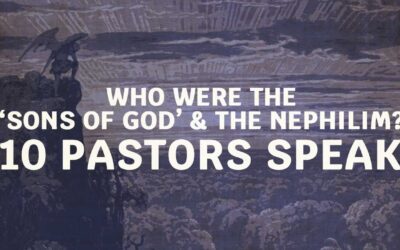Thanks to The Chosen TV series and Bible Project‘s stunningly animated videos illustrating Biblical concepts, finally some quality workmanship is being used to communicate Biblical truth!
One of the cofounders of The Bible Project, Tim Mackie is easily recognized as one of the voices and faces behind many of their videos, their online education classes and podcast.
According to Bible Project’s website, Tim is “a writer and creative director for BibleProject. He has a PhD in Semitic Languages and Biblical Studies.” He’s a professor at Western University.
Tim’s enthusiasm for scripture is infectious, as anyone who has listened to him knows! So when he talks about Genesis 6:1-4, it truly is a treat to get his perspective and see how little true ‘debate’ he sees in the interpretation of this passage.
This first video is one of Bible Project’s videos in their ‘Spiritual Beings’ Series. Skip ahead to around 3:10 to watch the relevant section…
In this next long-form video, Jon and Tim answer some viewer questions about the above video. The relevant section starts around 29:10.
These videos summarize Tim Mackey’s perspectives on the ‘sons of God’ and the Nephilim really well, but here are some other things he’s shared on the podcast.
So remember the concept of God’s heavenly staff team, the divine council, or the sons of God? In the Hebrew Scriptures, we’re told that some of these rebelled too.
Tim Mackey – Source
After the snake comes the rebellion of the sons of God in Genesis 6. We’re told that they have sex with women who then give birth to violent warrior giants.
Jon: Oh right, the Nephilim. These are probably the strangest characters in the whole Bible.
Tim: Well, strange from your point of view. But ancient readers knew exactly what was going on. The ancient kingdoms around Israel claimed to be founded and protected by giant warrior kings who were part human, part god and filled with divine wisdom.
Jon: Ah, I see. So the biblical authors are saying, “Hey, those warrior kings? They shouldn’t be honored.”
Tim: Right. In this story, they’re portrayed as human rebels who are captive to spiritual evil, spreading their violence in God’s good world.
Jon: Yeah. One of those kings in Genesis 10 goes on to build the city of Babylon.
Tim: Yes, Nimrod, whose name sounds like the Hebrew word for “rebel.” And his kingdom leads to the next rebellion, where humans exalt themselves in Babylon.
Jon: But God scatters that rebellion.
Tim: And when Moses, in Deuteronomy, looks back at that story, he says that’s the moment when God handed over the nations to worship the rebel host of heaven—the gods of money, sex, and military power. Moses is the first one to call them demons, that is, lesser spiritual beings.
Jon: So demons are spiritual forces at work behind corrupt human power structures.
Here’s the thing. There is a live tradition going all the way back to Genesis 6, has to do with the crazy story of the sons of Elohim sleeping with women. And that’s connected to the presence of giants in the biblical world.
The giants are called by many titles in the Old Testament. They are called the Nephilim. They’re also sometimes called the Rephaim. And the Rephaim, was both a name for ancient giants and for the spirits, the deceased life presence of these beings in the underworld, in the grave.
Jon: So Rephaim is just a synonymous term to the Nephilim?
Tim: Correct.
Jon: Why is there two terms?
Tim: Each one has its own background and history.Jon: Okay.
Tim: We’re told in the book of Deuteronomy, that then Nephilim are also called the sons of Anak by the people on the east of the Jordan: The Moabites and the Ammonites. Those people on the other side of the Jordan off called them the Rephaim. We conquered one of them. Moses did. His name was Og. And he had this gigantic bed, big iron. It’s Deuteronomy 2. Go read it. He says, “Big iron bed.” Moses says, “You can still go see it to this day.” Dude, this is so crazy.
Jon: It’s in a museum somewhere.
Tim: Yes, it’s in an ancient museum. You can go see this gigantic bed of Og, the king that Moses in Israel, Joshua killed. There’s this whole thing about giants.
Jon: Just to back up, sorry—
Tim: It’s all right. We said we weren’t going to talk about it. Now, we’re talking about it.
Jon: Genesis 6, the sons of God, the Divine Council crew come and have relations with human women in the story—
Tim: It’s another fall story. They see, of what’s good and they take. It’s now the heavenly beings having a rebellion.
Jon: The story is in the Bible.
Tim: Yes, it is.
Jon: And it’s one of those stories that is like, “Okay, that’s weird.” But then you actually see these characters, then Nephilim, the half breeds.
Tim: They live on the story. They’re half divine half human.
Jon: And they’re connected to these warrior giants, which isn’t just a Hebrew concept. Tim: No, no, no. That’s right.
Jon: This idea is all over the ancient world.Tim: Totally. The half god half man warrior giants that founded the kingdoms of old. Babylon’s founding legends are about them being founded by these half god half human warrior giants.
Jon: Gilgamesh was a giant.
Tim: Gilgamesh was a warrior giant. Nimrod in Genesis 10, is a warrior giant. Totally.
Jon: So these guys are all over the place, and then Joshua has to fight him.
Tim: Let’s just stop right there. The presence of Genesis 6 then in Genesis is trash talk story against Babylon founding mythology.
Jon: You think it’s cool to have these warrior giants—
Tim: You think they are your heroes, and build your cultures. No, dude.
Jon: It’s bad news.
Tim: They’re evil. They founded empires that have done great evil in the world and God’s going to bring them down. That’s Genesis 6 and the trail that it starts.
Jon: Genesis 6 is ancient trash talk.
Tim: It’s ancient trash talk against Babylonian foundation stories. Then these characters live on in the biblical story as these reminders of that divine-human rebellion in Genesis 6.
Jon: So this is like a third type of rebellious?
Tim: It’s another type of spiritual bad guy.
Jon: So we’ve got the spiritual rebellion of the Satan – the snake – we’ve got the rebellion of the sons of God who are supposed to lead the nations, and now we’re talking about a third type of rebellion that creates these have these half breeds.
Tim: These mutant giants that in the biblical story represent an unfortunate rebellion of other spiritual being, other hosts of heaven that did this thing.
Jon: They’re called the Rephaim.
Tim: Eventually, one of their titles is called the Rephaim. And the Giants exist in the Bible to be killed off by just three sets of heroes: by God and the flood, by Joshua in the conquest. I have a lot of homework to do here. Michael Heiser has done a lot of this in “Unseen Realm”. But the whole conquest story in Joshua, if you do your homework, they’re targeting the giant clans in Joshua.
Jon: Sheesh.
Tim: It’s a giant purge. Which makes perfect sense, because it’s God bringing another flood but through Joshua. And then the giants are finally done away with by David and his servants. And Goliath is the final ultimate giant. That story is the Messianic prototype David fighting an ultimate spiritual bad guy, Goliath. It’s an archetypal showdown.
Here’s the thing is that if, however, their divine and human…I know this sounds crazy, but this is the logic. If they’re fully divine and human, then just killing them dead and in the ground, they still live on in some way. And so the Rephaim becomes a title for evil spiritual presences that live on to terrorize people. These are the beings Jesus is encountering in the Gospels.
Jon: Just to be completely transparent, in the Hebrew Scriptures, the Rephaim are described as evil spirits.
Tim: Yes, they are,
Jon: It’s in Isaiah somewhere.
Tim: It’s in Isaiah 14 and Ezekiel 32. They are spiritual beings that are the remnant existence of these warrior mutants of old—
Jon: And then you get to Jesus and his encounter with these demons, and you’re like, “What are these guys?”
Tim: “Where did they come from?” Maybe you’ve ever asked yourself that “Where did these guys come from?”
Jon: “What is the deal with these?”
Tim: “Who are they?”
Jon: I just figured it was like the angels that rebelled with the Satan, but they seem different in some way.
Tim: That’s right. They are lurking in graveyards. They’re lurking out in the wilderness. They get people to destroy their own bodies. It’s very complex. This opens up a million questions, I understand. But why are they called impure spirits? Where did that term come from – because that the main name in the gospels in the New Testament?
Again, there’s two scholars that I mentioned, they’ve made the case that it’s a clue to the fact that they emerged from the dead corpses of the giant warriors.
Jon: Demons or the leftover spirit remains of the half breed giants. Welcome to your Bible.
Tim: In the one story in the gospels where these beings are given a title, they call themselves legion. It’s in the graveyard. Jesus meets that guy in the graveyard, it’s a crew of these.
Jon: It’s a battle.
Tim: And they give themselves a military title, legion. Jon: Which is also clue you into—Tim: Clue you back into Goliath and Og and the Nephilim and all that. I know that sounds crazy, but for the biblical authors, this was how they saw things. And this isn’t just the New Testament. If you look at Jewish literature in the same time period, everybody’s linking the presence of these spirits back to the Nephilim and the sons of God.
So this is a new rabbit hole for me. There’s a lot of questions I still have but—
Jon: So the short answer to the question is the demons that Jesus confronts aren’t connected to this idea of corporate power and authority.
Tim: They are distinct type of bad guy.
Jon: They are distinct type of bad guy. They have a different type of bad guy ammo.
Tim: That’s right. Three types of bad guys in Genesis 1 through 11. There’s the evil one, there’s the mutant giants who will live on past their death to terrorize individualism, then there’s the national sons of Elohim that become the powers and the authorities.
Jon: So when Jesus is confronting the demons, he’s not confronting the corporate national powers and authorities, he’s confronting this other strange thing that’s happening that’s also influencing humanity.
Tim: Yeah, people on individual level. And then when he goes to Jerusalem in the Gospel of Luke, he says, “I’m on the showdown.” He calls it “with the power of darkness.” And then he goes to Jerusalem and faces the rulers and authority.
Jon: So he takes on all of them.
Tim: Jesus takes on all three. We’re meant to see Jesus taking on the Genesis 3 bad guy, the Genesis 6 bad guys, and the Genesis 11 bad guys in the Gospel narrative.
Jon: Genesis 3 being the evil one, Genesis 6 being—
Tim: The Rephaim and Genesis 11 being the Elohim rulers and authorities. Once you see that that’s how the apostles think, and how almost all their Jewish contemporaries think and write, it all locks into place. The story becomes so much more coherent. And it sounds even more crazy for moderns to get into this way of seeing the world.
I’ve said this before, I just I’m tired of trying to rewrite the Bible to make it more rational.
Jon: Yeah. Make it a little more tame. I mean, evil as a spiritual reality is hard enough in a materialistic secular world to wrestle through. And now you’re saying, “Oh, it’s not as simple. There’s these three layers of evil in the biblical story and Jesus confronts them all.”
Tim: And Jesus, confront them all, which opens up many more cans of worms that we’ll continue to unpack.
Jon: I hope that didn’t discourage everyone from…
Tim: What else can I do but laugh? I never thought I would hear myself talking about these things. Anyway, the Bible, you got to go where it takes you.
Tim Mackey – Source





